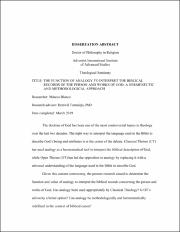| dc.contributor.author | Blanco, Marcos | |
| dc.date.accessioned | 2023-03-08T02:40:45Z | |
| dc.date.available | 2023-03-08T02:40:45Z | |
| dc.date.issued | 2019-03 | |
| dc.identifier.uri | https://dspace.aiias.edu/xmlui/handle/3442/484 | |
| dc.description | Unpublished Dissertation (PhD Religion)
Shelf Location: BT102 .B53 2019 ATDC | en_US |
| dc.description.abstract | The doctrine of God has been one of the most controversial topics in theology
over the last two decades. The right way to interpret the language used in the Bible to
describe God’s being and attributes is at the center of the debate. Classical Theism (CT)
has used analogy as a hermeneutical tool to interpret the biblical description of God,
while Open Theism (OT) has led the opposition to analogy by replacing it with a
univocal understanding of the language used in the Bible to describe God.
Given this current controversy, the present research aimed to determine the
function and value of analogy to interpret the biblical records concerning the person and
works of God. Has analogy been used appropriately by Classical Theology? Is OT’s
univocity a better option? Can analogy be methodologically and hermeneutically
redefined in the context of biblical canon?
In order to answer these questions, Chapter 2 analyzed and theologically
evaluated the function of both analogy (CT) and univocity (OT) by highlighting their
limitations; Chapter 3 advanced a new understanding of analogy by focusing on
methodology and hermeneutics; and Chapter 4 showed how canonical analogy as a
methodological and hermeneutical tool can be used to interpret the biblical descriptions
of two of God’s attributes: eternity and impassibility. The aim of this study, then, was to
present an alternative understanding of the function and value of analogy to interpret the
biblical records concerning the person and works of God.
The methodological and hermeneutical steps proposed here include:
1. Determine that the Bible alone is the material and presuppositional source to
interpret the biblical descriptions of God.
2. Perform a phenomenological exegesis in order to extract the main
presuppositions that are operative in the biblical text and are necessary to elaborate the
doctrine of God. Instead of borrowing these hermeneutical presuppositions from
philosophy, phenomenological exegesis looks for the operative primordial
presuppositions in the biblical text. Once the hermeneutical presuppositions have been
drawn from the Bible, biblical theology initiates the task of biblical exegesis itself.
3. Find out the explicit equivocal and univocal sides of the canonical analogy.
4. Elaborate a basic model from the biblical data. The ultimate goal is to outline a
pattern or model from the data by seeking to ensure that individual texts and isolated
pericopes eventually build a broader concept about God. Thus, microhermeneutical
exegesis informs macrohermeneutical presuppositions in an ongoing hermeneutical
spiral. | en_US |
| dc.language.iso | en_US | en_US |
| dc.publisher | Adventist International Institute of Advanced Studies | en_US |
| dc.subject | God -- Attributes. | en_US |
| dc.subject | God (Christianity) | en_US |
| dc.subject | God | en_US |
| dc.subject | Bible. -- Pentateuch -- Criticism, interpretation, etc. | en_US |
| dc.title | The Function of analogy to interpret the biblical records of the person and works of God : a hermeneutical and methodological approach | en_US |
| dc.type | Dissertation | en_US |

